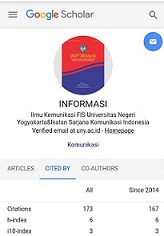STATE POSITION AMONG OF THE INFORMATION TECHNOLOGY PARADIGM: REVIEW OF THE MEDIA LITERACY MOVEMENT BY DIY KPID AND BTKP DIY
Abstract
The Democratic System of Pancasila that has been chosen by Indonesian founders give several consequences. The state needs to be responsible for regulating equality policies for every citizen. Not only about the issue of equitable economic resources but also equal access to information. In the context of the country, democracy and markets equal access to information can be understood as information technology paradigm. This paradigm means that all systems that use by technology information are defined by networking sense, which is an empowering citizen to influence a wide variety of processes. Through the observation and depth of methods, this research examines the role of the Yogyakarta Provincial Education and Sports Agency for educating students and the equitable distribution of information technology. The city was chosen as a research umbrella carried out by Media Literacy Activists Network in 2017. As result of this research shows that literacy education efforts were carried out by Indonesia Broadcasting Commision of Yogyakarta Special Region were still struggling in a protectionist perspective, while The Institute of Government Education Communication Technology in Yogyakarta Province is using creative media approach as an effort to use technology as part of empowerment.
Sistem Demokrasi Pancasila yang dipilih oleh para pendiri bangsa Indonesia melahirkan beberapa konsekuensi logis. Diantaranya menuntut peran negara dalam mengatur kebijakan pemerataan keadilan. Keadilan tidak hanya pada persoalan pemerataan sumber-sumber ekonomi, namun juga pemerataan akses informasi. Dalam masyarakat, akses informasi ini di sebut sebagai paradigma teknologi informasi. Paradigma ini berarti ketika semua sistem yang menggunakan teknologi informasi didefinisikan oleh ‘logika jaringan’ yang memungkinkan mereka memengaruhi suatu varietas luas proses-proses dan organisasi-organisasi. Ketika “logika jaringan” tersebut telah terjadi dengan melimpahnya akses informasi di dunia maya lalu langkah-langkah seperti apa yang diterapkan oleh Negara khususnya Dinas Pendidikan dan Olahraga Provinsi Yogyakarta untuk mendidik siswa dan guru sebagai bagian dari pemerataan keadilan dalam teknologi informasi? Kota ini dipilih berkaitan dengan payung riset yang dilakukan bersama-sama dengan Jaringan Pegiat Literasi Media (Japelidi) pada tahun 2017. Penelitian ini menggunakan instrumen yang telah disusun melalui pengayaan teori digital literasi berkaitan dengan tujuan penelitian yaitu, memetakan aktivitas Literasi Digital. Melalui desk study, observasi dan wawancara mendalam sebagai metode, peneliti menemukan upaya pendidikan literasi yang dilakukan KPID DIY masih berkutat dalam perspektif proteksionis sedangkan BTKP DIY lebih pada pendekatan media kreatif sebagai upaya menggunakan teknologi sebagai bagian dari pemberdayaan.
Keywords
Full Text:
PDFReferences
Ashley. Seth; Maksl, Adam; and Craft, Stephanie. (2017). "News Media Literacy and Political Engagement: What’s the Connection?", Journal of Media Literacy Education, Volume 9, No. 1, hal.79 -98.
Castells. M. (2009). The Power of Identity: The Information Age: Economy Society, and Culture Volume II, 2nd Edition with a New Preface. Wiley-Blackwell.
Castells. M. (2012). Networks of outrage and hope: Social movements in the Internet age. Cambridge, UK: Polity.
Donald J. Leu, Jr., Charles K. Kinzer, Julie L. Coiro, and Dana W. Cammack. (2004). Toward a Theory of New Literacies Emerging From the Internet and Other Information and Communication Technologies From Theoretical Models and Processes of Reading. (5th ed.). International Reading Association.
Fedorov. A. (2011). Modern media education models. Acta Didactica Napocensia, Volume 4, No. 1, hal.73-82.
Hobbs, R., & Jensen, A. (2009). The Past, Present, and Future of Media Literacy Education. Journal of Media Literacy Education, Volume 1, hal. 1-11.
Jenkins. H. (2006). Convergence culture: Where old and new media collide. New York, NY: New York University Press.
Jensen. A.P. (2008). Beyond Mediatized Transmissions of Youth Culture: A Study in Digital Citizenship. Youth Theatre Journal, Volume 23, No. 1, hal.14-28.
Lee. A.Y. L. (2010). Media Education: Definitions, Approaches and Development around the Globe. New Horizons in Education, Volume 58, No. 3, hal. 1-13.
Leu, Don & K Kinzer, Charles & Coiro, Julie & W Cammack, Dana. (2004). Toward a Theory of New Literacies Emerging From the Internet and Other Information and Communication Technologies. Theoretical Models and Processes of Reading. 5th ed. International Reading Association.
Livingstone. S. dan Bovill, M. (1999). Young People New Media. Report of the Research Project Children Young People and the changing Media Environment. London: LSE.
Martinsson. Johanna. (2009). Communication for Governance and Accountability Program (CommGAP) COMMGAP DISCUSSION PAPERS Innovative Solutions FOR GOVERNANCE The Role of Media Literacy in the Governance Reform Agenda. Washington DC: Communication for Governance & Accountability Program (CommGAP).
McLuhan. Marshall. (1964). Understanding Media. New York: McGraw-Hill.
Mihailidis. Paul dan Benjamin Thevenin. (2013). Media Literacy as a core Competency for Engaged Citizenship in Participatory Democracy. American Behavioral Scientist.Volume 57, No. 11, hal. 1611-1622.
Neuman. W.L. (2006). Social Research Methods: Qualitative and Quantitative Approaches. 7th ed. Harlow: Pearson Education.
Nugroho, Garin dan Dyna Herlina. (2013). Krisis dan Paradoks Film. Jakarta: Gramedia Pustaka Utama.
O’Neill. B. (2000). ‘Media Education in Ireland’. Irish Communications Review. Volume 8, hal. 57-64.
O’Neill. B. (2011). Media Literacy in Ireland: From Protectionism to Participation. Presentation at Media Literacy – A Critical Moment Conference. Dublin.
O'Neill. B., dan Barnes, C. (2007). Media Literacy and The Public Sphere: a Contextual Study for Public Media Literacy Promotion in Ireland. Dublin: Centre for Social and Educational Research, Dublin Institute Technology.
R. Hobbs. dan A. Jensen. (2009). The Past, Present, and Future of Media Literacy Education. The National Association for Media Literacy Education’s Journal of Media Literacy Education 1.
R. Hobbs. (2010). Digital and Media Literacy: A Plan of Action a White Paper on the Digital and Media Literacy Recommendations of the Knight Commission on the Information Needs of Communities in a Democracy. Washington: The Aspen Institute.
Rainie. L., Brenner, J., and Purcell, K. (2012). Photos and videos as social currency online. Pew Internet & American Life Project.
Ritzer. George. Douglas J. Goodman. (2012). Teori Sosiologi dari Teori Sosiologi Klasik Sampai Perkembangan Mutakhir Teori Sosial Postmodern. Bantul: Kreasi Wacana.
Rogers. Everett M. (1983). Diffusion of Innovations, Third Edition. New York, NY: The Free Press.
Salomon. G. (1979). Interaction of media, cognition and learning. San Francisco, CA: Jossey Bass.
Sen. Khrisna, dan David T Hill. (2000). Media, Culture and Politics in Indonesia. Oxford University Press.
Tornero. Pérez J.M., Varis, Tapio. (2010). Media Literacy and New Humanism. Moscow: UNESCO Institute for Information Technologies in Education.
Policy Brief, UNESCO, 2011.
DOI: https://doi.org/10.21831/informasi.v48i2.15873
Refbacks
- There are currently no refbacks.
Copyright (c) 2019 Firly Annisa
Supervised by
Our Journal has been Indexed by:
Informasi by http://journal.uny.ac.id/index.php/informasi is licensed under a Creative Commons Attribution-NonCommercial 4.0 International License.














